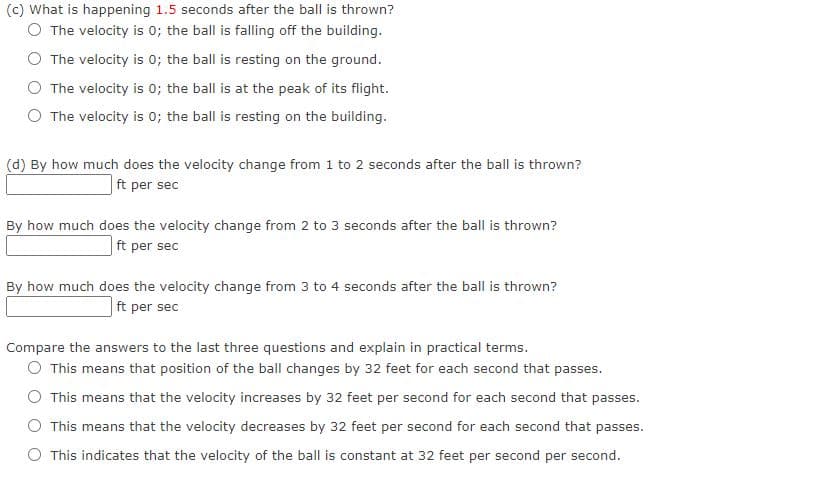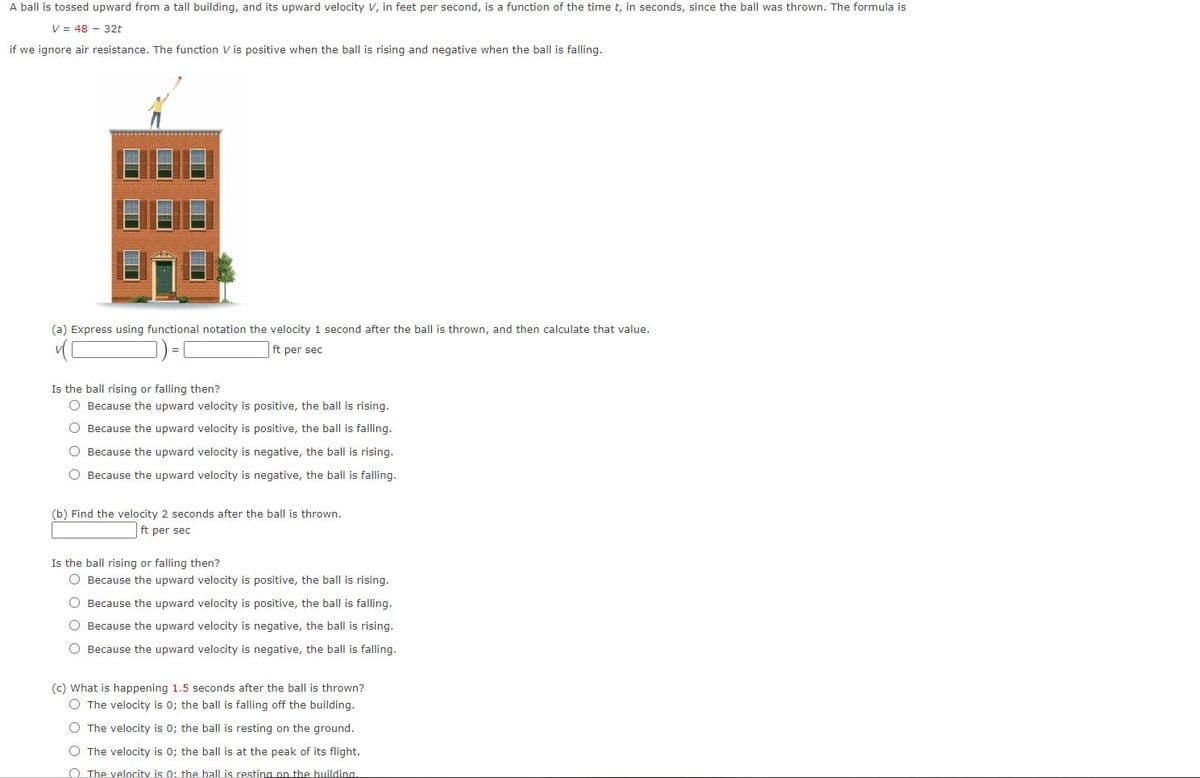A ball is tossed upward from a tall building, and its upward velocity V, in feet per second, is a function of the time t, in seconds, since the ball was thrown. The formula is V= 48 - 32t if we ignore air resistance. The function V is positive when the ball is rising and negative when the ball is falling. (a) Express using functional notation the velocity 1 second after the ball is thrown, and then calculate that value. ft per sec Is the ball rising or falling then? O Because the upward velocity is positive, the ball is rising. O Because the upward velocity is positive, the ball is falling. O Because the upward velocity is negative, the ball is rising. O Because the upward velocity is negative, the ball is falling. (b) Find the velocity 2 seconds after the ball is thrown. ft per sec Is the ball rising or falling then? O Because the upward velocity is positive, the ball is rising. O Because the upward velocity is positive, the ball is falling. O Because the upward velocity is negative, the ball is rising. O Because the upward velocity is negative, the ball is falling. (c) What is happening 1.5 seconds after the ball is thrown? O The velocity is 0; the ball is faling off the building. O The velocity is 0; the ball is resting on the ground. O The velocity is 0; the ball is at the peak of its flight.
A ball is tossed upward from a tall building, and its upward velocity V, in feet per second, is a function of the time t, in seconds, since the ball was thrown. The formula is V= 48 - 32t if we ignore air resistance. The function V is positive when the ball is rising and negative when the ball is falling. (a) Express using functional notation the velocity 1 second after the ball is thrown, and then calculate that value. ft per sec Is the ball rising or falling then? O Because the upward velocity is positive, the ball is rising. O Because the upward velocity is positive, the ball is falling. O Because the upward velocity is negative, the ball is rising. O Because the upward velocity is negative, the ball is falling. (b) Find the velocity 2 seconds after the ball is thrown. ft per sec Is the ball rising or falling then? O Because the upward velocity is positive, the ball is rising. O Because the upward velocity is positive, the ball is falling. O Because the upward velocity is negative, the ball is rising. O Because the upward velocity is negative, the ball is falling. (c) What is happening 1.5 seconds after the ball is thrown? O The velocity is 0; the ball is faling off the building. O The velocity is 0; the ball is resting on the ground. O The velocity is 0; the ball is at the peak of its flight.
Functions and Change: A Modeling Approach to College Algebra (MindTap Course List)
6th Edition
ISBN:9781337111348
Author:Bruce Crauder, Benny Evans, Alan Noell
Publisher:Bruce Crauder, Benny Evans, Alan Noell
Chapter1: Functions
Section1.4: Functions Given By Words
Problem 6E
Related questions
Question

Transcribed Image Text:(c) What is happening 1.5 seconds after the ball is thrown?
O The velocity is 0; the ball is falling off the building.
The velocity is 0; the ball is resting on the ground.
O The velocity is 0; the ball is at the peak of its flight.
O The velocity is 0; the ball is resting on the building.
(d) By how much does the velocity change from 1 to 2 seconds after the ball is thrown?
ft per sec
By how much does the velocity change from 2 to 3 seconds after the ball is thrown?
ft per sec
By how much does the velocity change from 3 to 4 seconds after the ball is thrown?
|ft per sec
Compare the answers to the last three questions and explain in practical terms.
O This means that position of the ball changes by 32 feet for each second that passes.
O This means that the velocity increases by 32 feet per second for each second that passes.
O This means that the velocity decreases by 32 feet per second for each second that passes.
This indicates that the velocity of the ball is constant at 32 feet per second per second.

Transcribed Image Text:A ball is tossed upward from a tall building, and its upward velocity V, in feet per second, is a function of the time t, in seconds, since the ball was thrown. The formula is
V = 48 - 32t
if we ignore air resistance. The function V is positive when the ball is rising and negative when the ball is falling.
(a) Express using functional notation the velocity 1 second after the ball is thrown, and then calculate that value.
ft per sec
Is the ball rising or falling then?
O Because the upward velocity is positive, the ball is rising.
O Because the upward velocity is positive, the ball is falling.
O Because the upward velocity is negative, the ball is rising.
O Because the upward velocity is negative, the ball is falling.
(b) Find the velocity 2 seconds after the ball is thrown.
ft per sec
Is the ball rising or falling then?
O Because the upward velocity is positive, the ball is rising.
O Because the upward velocity is positive, the ball is falling.
O Because the upward velocity is negative, the ball is rising.
O Because the upward velocity is negative, the ball is falling.
(c) What is happening 1.5 seconds after the ball is thrown?
O The velocity is 0; the ball
falling
the building.
O The velocity is 0; the ball is resting on the ground.
O The velocity is 0; the ball is at the peak of its flight.
O The velocity is 0: the ball is resting on the building.
Expert Solution
This question has been solved!
Explore an expertly crafted, step-by-step solution for a thorough understanding of key concepts.
This is a popular solution!
Trending now
This is a popular solution!
Step by step
Solved in 3 steps

Knowledge Booster
Learn more about
Need a deep-dive on the concept behind this application? Look no further. Learn more about this topic, advanced-math and related others by exploring similar questions and additional content below.Recommended textbooks for you

Functions and Change: A Modeling Approach to Coll…
Algebra
ISBN:
9781337111348
Author:
Bruce Crauder, Benny Evans, Alan Noell
Publisher:
Cengage Learning

Big Ideas Math A Bridge To Success Algebra 1: Stu…
Algebra
ISBN:
9781680331141
Author:
HOUGHTON MIFFLIN HARCOURT
Publisher:
Houghton Mifflin Harcourt

Trigonometry (MindTap Course List)
Trigonometry
ISBN:
9781337278461
Author:
Ron Larson
Publisher:
Cengage Learning

Functions and Change: A Modeling Approach to Coll…
Algebra
ISBN:
9781337111348
Author:
Bruce Crauder, Benny Evans, Alan Noell
Publisher:
Cengage Learning

Big Ideas Math A Bridge To Success Algebra 1: Stu…
Algebra
ISBN:
9781680331141
Author:
HOUGHTON MIFFLIN HARCOURT
Publisher:
Houghton Mifflin Harcourt

Trigonometry (MindTap Course List)
Trigonometry
ISBN:
9781337278461
Author:
Ron Larson
Publisher:
Cengage Learning

Algebra & Trigonometry with Analytic Geometry
Algebra
ISBN:
9781133382119
Author:
Swokowski
Publisher:
Cengage

Glencoe Algebra 1, Student Edition, 9780079039897…
Algebra
ISBN:
9780079039897
Author:
Carter
Publisher:
McGraw Hill
